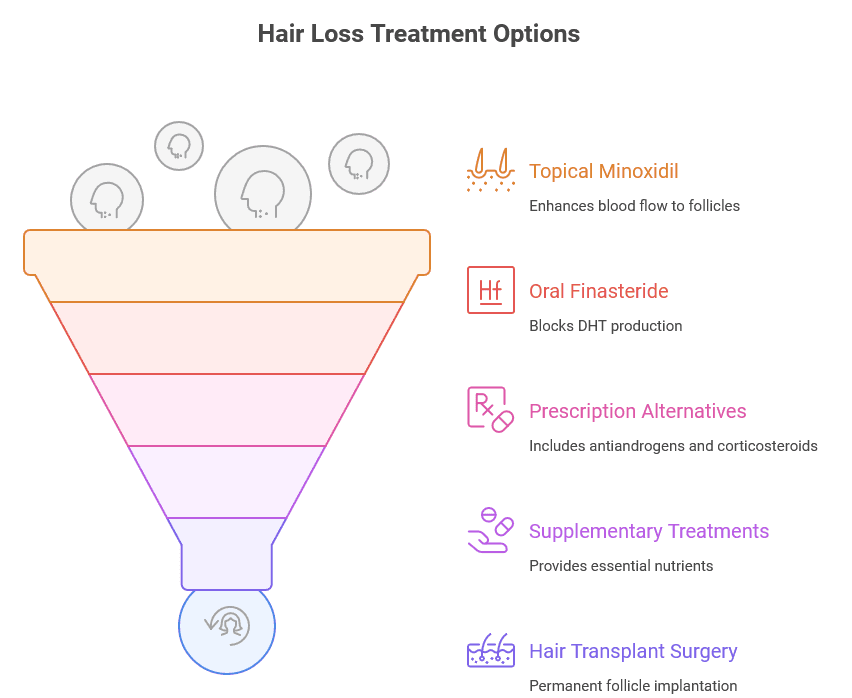The hard truth everyone must come to terms with is that thinning hair and the appearance of bald spots are something that affects both men and women over a certain age. Unfortunately, as people associate their youth and beauty with long, dense strands, suddenly losing these desirable qualities can be a big blow to one’s feeling of self-worth.
That is why there is an entire field of medicine dedicated to finding the most effective hair loss treatment. While the advancement of FUE and DHI transplants has actually provided us with a reliable solution, there are also non-invasive options—various medications that slow down the balding process.
We will look at the primary causes and go over all the currently approved drugs to show you how they work and who they are best for.
Did you know?
A new cross-sectional analysis of over 1,000,000 self‑reported entries from 2020‑2024 found that 86.4% of respondents reported visible hair loss (43.7% mild, 31.6% moderate, and 11.2% severe). The hard truth everyone must come to terms with is that thinning hair and the appearance of bald spots are something that affects both men and women over a certain age.
What Causes Hair Loss?
The usual suspect here is androgenetic alopecia, a genetic predisposition toward thinning and baldness that typically starts in people’s early to mid-30s. Other medical conditions that commonly lead to hair loss include:
- Alopecia areata and other autoimmune diseases
- Changes in hormone levels
- High amounts of stress
- Fungal infections
With some of these conditions, the shedding is only temporary, and everything returns to normal after successful treatment. However, if it’s a genetic factor, you will need to take medication continually to stop the progression.
FDA-Approved Medications for Hair Loss
Because there are different types of hair loss, scientists have developed several unique drugs and other treatments to cover each specific scenario. These are the thoroughly tested and recommended options.
Topical Minoxidil (Rogaine)
This medication improves blood flow to the follicles and is the only one officially approved for treating female pattern hair loss, though it works great for men as well. It is applied directly to the scalp, which you should gently massage for about a minute, and then let the area dry. Always wash your hands after applying the solution.
Oral Finasteride (Propecia)
Unlike the previous option, this drug addresses the cause of the issue directly—it stops the body from converting testosterone into DHT. It is able to slow the rate of hair loss or even stop it completely, although the side effects include depression and erectile dysfunction.
Prescription-Only Alternatives
Among the alternatives to the two common drugs mentioned above are platelet rich plasma (PRP) therapy and different types of prescription medication, which we will list below.
Antiandrogens (e.g., Spironolactone, Birth Control Pills)
These are used to treat hair loss in women, primarily by binding to the same receptors in follicles that DHT usually does, taking this hormone’s seat at the table, so to speak. In doing so, they minimize the side effects like shedding.
Corticosteroids
With this type of treatment, it’s all about preventing the body from attacking its own cells in case of autoimmune diseases. You can apply them topically or inject them into the scalp.
Antifungal Medications
These are special shampoos that kill the fungal infections that may be causing inflammation and other issues in the scalp, thus preventing any further hair loss caused by them.
Supplementary Treatments
Another big reason why your hair may be thinning is that the scalp isn’t receiving the nutrition it needs. While some medication promotes better blood flow, you must also provide each hair follicle with the proper vitamins and minerals.
Biotin
Also known as vitamin B6, this is a building block of keratin, which makes up tissues like your hair. Simply having more of the raw material leads to thicker shafts that are less prone to breaking.
Zinc
An essential component for follicle regeneration and keeping the oil glands from producing too much sebum and clogging pores, which can lead to inflammation.
Vitamin D
You need a steady supply of this vitamin to allow the follicles to go through all their natural cycles, instead of being stuck in the dormant phase.
Saw Palmetto
There is some evidence to suggest that this supplement may help inhibit DHT to an extent, but more research is needed to come to a conclusive answer.

Hair Transplant Surgery for Long-Lasting Results
The only permanent solution is to extract follicles from the back of the head and implant them into the bald areas. With that in mind, let’s see what you can expect from the two most popular methods of hair transplant in Turkey.
Feature | ||
Precision | Good, depends on the surgeon’s skill | Very high — precise angle, depth, and direction |
Density | Natural results, moderate density | Higher density in smaller areas |
Healing | 7–10 days | 2–3 days |
Procedure time (3000 grafts) | 6–8 hours | 8–10 hours (may be split into two sessions) |
Typical cost | $2000–$3500 | $2700–$4000 |
Best for | Covering larger bald areas | Hairline design, touch-ups, maximum density |
FAQs
Is hair loss reversible?
Yes, but only in specific cases. For example, if you have thinning hair as a result of stress or illness, removing the cause can stop the side effects, whereas genetic baldness can only be slowed down with drugs.
Can women take finasteride?
No. Studies have shown it to be ineffective, while exposing women to health risks, and there are much safer alternatives like minoxidil.
How long does it take for medication to work?
It usually takes around 4–6 months to see tangible results from minoxidil, and some 6–12 months when using finasteride. With antiandrogens or corticosteroids, it’s usually about 3–4 months to see the initial results, though it may take a year to get the full effect with the former.
Is a hair transplant a permanent solution?
It is, but you may need additional touch-ups in a few years or a decade. That’s because while the donor grafts will ensure steady hair growth for the rest of your life, the surrounding hair at the recipient area may continue to fall out as you age.
Who is eligible for a hair transplant?
Any person in their early thirties or older, with a steady pattern of hair loss, who is also in good general health and has plenty of available hair at the back of the head, is considered a viable candidate.

